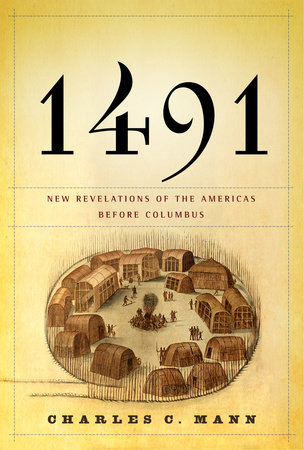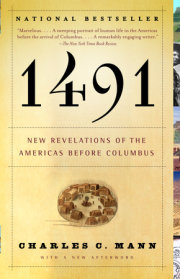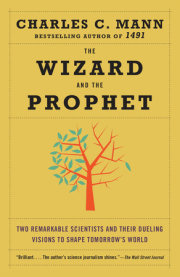In the last twenty years, archeologists and anthropologists equipped with a battery of new scientific techniques have made far-reaching discoveries that have completely changed their understanding of what the Americas were like before Columbus's arrival. Most of us learned in school that Indians crossed the Bering Strait 12,000 years ago, that they were few in number, and that they lived so lightly on the land that much of the Americas was essentially a wilderness. Most researchers now believe that every one of these statements is wrong. Indians were here far longer than previously believed, they lived in vastly greater numbers than had been thought, and they transformed the American landscape thoroughly. Not only has this fascinating new knowledge vastly altered our understanding of our history, it has enormous implications for today's environmental disputes. Charles Mann illuminates all of these issues and reports on how these discoveries were made in this enthralling journey of scientific exploration.
Mann begins by showing how, beginning in the 1970s, researchers came to realize that the Indian population in 1491 must have been ten or twenty times higher than previously thought—there were more people in the Americas in 1491, the scientists came to believe, than in Europe; the Amazon delta may have been inhabited by more people in 1491 than it is now; cities including the Aztec capital of Tenochtitlan were bigger than any city in Europe. And when European diseases swept through these societies, killing more than 90 percent of the people, it was the greatest demographic disaster in human history.
Mann shows how scientists learned that these much bigger societies were far more advanced than had been thought, and much older, as well. The Indian development of modern corn from a weed that looks nothing like it is still the most complex and far-reaching piece of genetic engineering ever performed. Indians clearly were traveling a different but equally sophisticated path as Europeans.
In 1491, Mann presents a riveting, compelling, eye-opening work of science.
“A superbly written and very important book: by far the most comprehensive synthesis I’ve ever seen of the growing body of evidence that our most deep-rooted ideas about the peopling of the Western hemisphere and the kinds of societies that had developed there by the time of European contact are fundamentally wrong. Charles C. Mann is one of those rare writers who can make scholarly concepts exciting and accessible without trivializing them. In 1491 he has integrated the latest research in many different areas with his own insights and experiences to produce a fascinating and addictively readable tour through the ‘New World’ before its ‘discovery.’ His book is, above all, a wonderful, unsentimental act of restitution—challenging centuries of cultural contempt and willful blindness to show just how vigorous, various, densely populated and profoundly human the pre-Columbian Americas really were.” —James Wilson, author of The Earth Shall Weep: A History of Native America
“The bad news is that everything you were taught about the peopling and people of the Americas before Columbus is probably wrong. The good news is that the real story is bigger, grander and more fascinating than you ever imagined. Charles Mann, a meticulous researcher and captivating writer, has produced the most enthralling book I’ve ever read on the first Americans.” —Tim Cahill, author of Lost in My Own Backyard, Hold the Enlightenment and Jaguars Ripped My Flesh
“We all know the first Americans wrote, built cities, and erected monuments, but they also changed the landscape. Well-informed in the ways of Aztec, Inca, Maya, Amazonian and Mound Builder, Mann engagingly reviews the social, environmental, and even the genetic conditions that set up the conquest that would follow the clash between two worlds—a clash not only among cultures but among ecosystems as well.” —Anthony Aveni, author of Skywatchers of Ancient Mexico and Empires of Time, Russell B. Colgate Professor of Astronomy and Anthropology, Colgate University
“If you accept that there were tens of millions of people in the Americas in 1492, the common belief among the experts today, then you cannot reject what Charles Mann has to say. We all have been taught what the human species gained by the European invasion of the Americas. Now we have to consider what we, all of us, lost.” —Alfred W. Crosby, author of Ecological Imperialism and The Columbian Exchange, Professor Emeritus of Geography, American Studies and History, University of Texas
“This is a volume of unparrelleled historical and hemispheric sweep. Through a lively and comprehensive review, Mann brings together the most recent research from many fields to truly show us the New World in 1491—not a world of simple savages but rather one of thriving cities, states and empires, trade networks extending throughout the hemisphere, and landscapes everywhere shaped by native management. The civilizations of the Americas rivaled or exceeded those of Europe. This is the first volume that reveals the scope of the cultural loss created by the ‘great dying.’ A brilliant synthesis and sobering meditation on one of the planet's great tragedies.” —Susanna Hecht, author of The Fate of the Forest: Developers, Destroyers, and Defenders of the Amazon, Professor of Urban Planning, Associate Director, School of Public Policy and Social Research, University of California at Los Angeles
“In his comprehensive new book, 1491, Charles Mann offers a comprehensive overview and an urgently needed update on the main archaeological and historical issues in the Americas before European arrival. From the Bering Strait to the Strait of Magellan, he brings forth the main academic controversies and presents them not merely as scholarly squabbles but as the issues that help shape the way we live in the modern world. In a lively and well written book, Charles Mann helps us to see the Americas in a new historical light.” —Jack Weatherford, author of Indian Givers and Genghis Khan and the Modern World, Professor of Anthropology, Macalester University
“Charles Mann takes us into a complex, fascinating and unknown world, that of the Indians who lived in this hemisphere before Columbus. He gently demolishes entrenched myths, with impressive scholarship, and with an elegance of style which makes his book a pleasure to read as well as a marvelous education.” —Howard Zinn
“In the tradition of Jared Diamond and John McPhee, a transforming new vision of pre-Columbian America.” —Richard Rhodes
“Every American knows it was a vast new world that Columbus found in 1492, and most imagine it was a thinly peopled paradise of plants, animals and hunter-gatherers waiting for civilization. The reality, Charles C. Mann tells us in his startling new book about the world before Columbus, is very different—two continents teeming with languages, cultures and mighty cities as big, as rich and even more populous than the capitals of Europe. But one thing the New World lacked—resistance to the diseases of the old. 1491 is lively and readable, filled with excitements and sorrows–a major contribution to our understanding of the achievements and the fate of the people we call Indians.” —Tom Powers
“When does American history begin? The old answer used to be 1492, with the European arrival in the Americas. That answer is no longer politically or historically correct. For the last thirty years or so historians, geographers and archaeologists have built up an arsenal of evidence about the residents of North America after the ice receded and before the Europeans arrived. Mann has mastered that scholarship and written the most elegant synthesis of the way we were before the European invasion.” —Joseph J. Ellis, author of His Excellency: George Washington
“Charles Mann has achieved the near impossible: distilling and reconciling the disparate ideas and findings of generations of scholars concerning the greatest collision of cultures ever, that of the Columbian Encounter. Written in a skillful, thoroughly enjoyable style that will please both the lay public and professional, this volume will immediately become a classic and the authoritative source on life in the Western Hemisphere before and immediately after 1491.” —Williams I. Woods, director of Environmental Studies, University of Kansas
“1491 is an eye-opening book that requires us to rethink virtually every assumption we have had about the Western Hemisphere before the arrival of Europeans. Charles Mann makes it clear that the notion of an ‘empty wilderness’ couild not be further from the truth. 1491 will change the way we think about wilderness and the ways humans have shaped the environment.” —Jan Dizard, Charles Hamilton Houston Professor of American Culture, Amherst College













